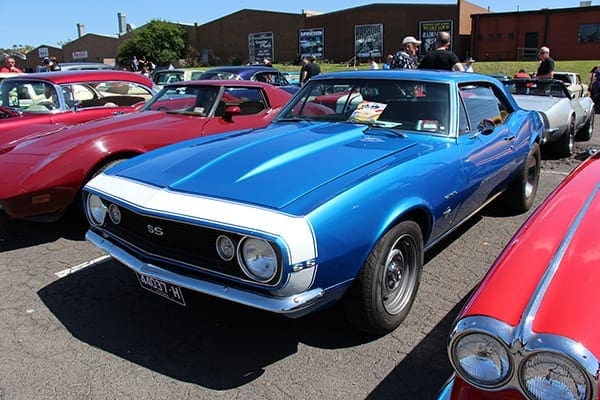
A 1967 Camaro similar to one driven by Chuck Mayes of Fayetteville, winner of the first drag races sponsored by the Northwest Arkansas Auto Association in 1975. The races were held on Ford Avenue in Springdale. Photo courtesy Sicnag/flickr.com
Last year we fielded a question about a “race track east of Springdale.” Nobody here knew about the track but sure enough, with a little digging and numerous phone calls, we rediscovered it—a fine little oval dirt track for stock car racing that thrived for a while and then disappeared. (See my article in the May 2014 Shiloh Museum newsletter.)
We love these interesting revelations about our history. They remind us of how much we don’t know, but they reward us with new insight. And it happened again when a researcher recently contacted Mayor Doug Sprouse’s office, and then, the Shiloh Museum, wanting to know about drag racing in Springdale. The person making the inquiry heard that back in the 1960s there was a drag strip in Springdale, and they were curious to see what we knew about it.
The answer was a big fat zip. Just like the last auto racing track question, nobody at the museum had heard of a drag strip, and no research files existed. There was some confusion at first, as some amongst us thought that this latest inquiry had to do with that roundy-round track mentioned previously. That was a circle track, where cars race for a number of laps on dirt. This question was about a drag strip, a different flavor of racing where cars line up side-by-side to see who can accelerate the quickest over a straight paved quarter-mile, hopefully with plenty of room to stop after the finish line. We found no evidence of a built-for-the-purpose drag strip in Springdale, but we did find that the Northwest Arkansas Automobile Association (NAAA) blocked off Ford Avenue at times during the 1970s (back then it was a dead-end lane just east of the Springdale Airport) and hosted some drag racing there. And it appears that they did it legally with permission from the Springdale police department.
Now that question of legality is important. Growing up in Springdale, I’d been involved in some drag racing here and there, but none of it was even remotely legal. The closest drag strips were in Tulsa or up in Kansas. That was inconvenient, so a lonely straight stretch of asphalt late at night would serve as a clandestine drag strip. You get two guys with hot cars together, and eventually somebody wants to know who’s faster. Maybe place a few friendly bets for kicks.
In the late 70s and early 80s I saw or heard about drag racing on Elm Springs Road, Friendship Road, Butterfield Coach Road, and occasionally on Hwy. 265 after it was widened to four lanes. Fayetteville kids wore out the road at the industrial park, using the railroad tracks to mark the end of their quarter-mile. There were never timers, no fancy starting lights. Some brave (or foolish) soul would stand between the cars with a handkerchief or a flashlight to signal when to go. Just line ’em up and go before somebody called the cops. Of course this was very dangerous and completely illegal, so kids, don’t even try this today!
My generation certainly didn’t invent this form of lunacy; we knew it had been going on for quite some time. The old timers used to organize their races (and bets) at Springdale’s Vic Mon drive-in and then proceed to Hwy. 264 to line up in front of Vanzant’s orchard and race back towards Hwy. 71. Sometimes drag races would just “happen” when two hot cars wound up next to each other at a stoplight. Like scenes from the movie American Graffiti, racing on public roads happened all over the country and law enforcement agencies were looking for ways to control it in the name of public safety.
And that brings us back to the NAAA blocking off Ford Avenue. Lawmen around the country were getting creative in their efforts to curb illegal street racing. As a result, various programs sprang up to provide hot-rodding kids a safe and supervised place to exercise their cars. While we don’t know the details, the NAAA may have been participating in one of these programs when they worked with local officials to block off Ford Avenue. During the summer of 1975 they held several drag races there, with cash prizes for the top contenders. While most of the racers hailed from Springdale, the events drew competitors from all over Northwest Arkansas. The folks with the NAAA charged competitors from two dollars to ten dollars to compete, but spectators were allowed to watch for free. In the newspaper ads for the races, the Springdale police warned folks to restrict their racing to Ford Avenue and only during the sanctioned races. Any other street racing would be punished with stiff fines and other penalties.
Like I said, we really don’t know all the details about how this came to be. We do know that the last legal drag race on Ford Avenue was held on August 31, 1975, and after that there is no more mention of such in the local newspapers.
If anybody has information about the NAAA back in the 1970s and their dealings with local law enforcement, we’d be grateful if you would contact the museum. Ask for me—we might know some of the same folks. I think that the statute of limitations has expired, so our past transgressions are most likely forgiven.
As for those who still feel the urge to race on public streets, I’d strongly advise against it! Maybe you can come to an arrangement like the NAAA and find a way to race legally. That would NOT be a drag. That would be drag racing.
Curtis Morris is the Shiloh Museum’s exhibits manager.

0 Comments